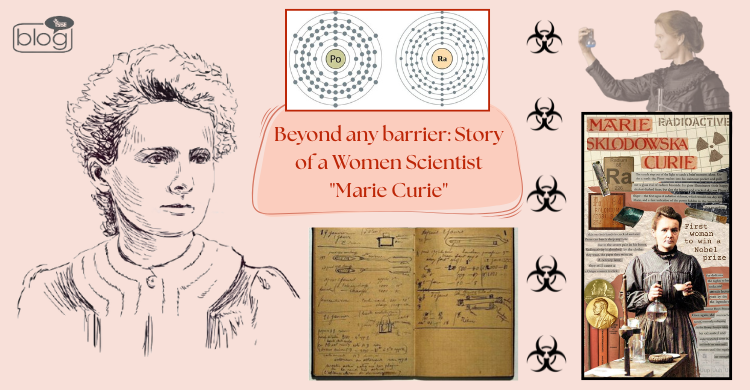“She didn’t just show revolution in research history; she tried to open the path of possibilities for every woman.”
A woman who brought revolution in the perception of girls’ education and their productivity. She is the one who is still alive among us through her work.
How did she manage to achieve two Nobel Prizes in different subjects, and that too, when women’s access was limited? How was her journey from Maria to Marie? Till now, people need overprotection to see or touch her lab accessories, but why?
Let’s know all this.
Marie’s Early Education
Marie Curie was born as Maria Skłodowska in 1867 in Warsaw, the Russian Empire (today’s Poland). Her parents were teachers by profession, and due to this, she was fond of learning & knowing new things, especially because she had a deep interest in Physics & Mathematics. Their economic condition was not so good; it was precarious. At the age of 11, she lost her mother due to Tuberculosis.
After many traumatizing situations, she didn’t give up; rather, she decided to continue her studies at any cost. She was a topper, but at that time, the Russian Empire banned women’s education. So, they had to complete their further education secretly at the Flying University. Maria (Marie) & her sister Bronya made a plan that they would help each other in their study financially. When Bronya completed her medical degree in Paris, she started to pay for Maria’s education at Sorbonne University, Paris. From that point, 24-year-old Maria became Marie (the French version of her name).
One Step to Her Research-
In 1893, she completed her degree in Physics from the Sorbonne University and also earned a diploma in Mathematics. Then in 1894, she married Pierre Curie, who was a physicist & colleague in the same field. Even after marriage, she continued her studies and completed a Doctor of Science in 1903 & her thesis topic was ‘Radioactivity’.
A French Physicist, Henry Becquerel, tried his best to find this in uranium but failed. Marie decided to take his research forward. This also inspired Pierre, and he decided to help his wife in this revolutionary research. Both of them started their hard work in the lab, examined many substances, and tried to find any sign of radioactivity. They concluded that pitchblende must contain other radioactive materials, as it was determined to be more radioactive than uranium. They were able to extract two previously unidentified elements from it: Radium (Ra) and Polonium (Po)-named after her birthplace, Poland, both of which are more radioactive than Uranium. Ra was 900 times and Po was 400 times more radioactive than Uranium.
Nobel Prizes in Two Different Subjects-
In 1903, Marie Curie became the first woman to win the Nobel Prize for her remarkable studies of radiation phenomena. She shared this with her husband, Pierre Curie, & Physicist Henry Becquerel. She became the director of the Curie Laboratory at the Curie Institute after receiving another Nobel Prize in chemistry in 1911 for the isolation of radium.
Pierre Curie was the support system of Marie Curie. But after his sudden death, Marie was left alone with their two daughters, who were the only sign of their selfless love & friendship. Then, she was offered her husband’s academic post as Professor. From this point, Marie broke another barrier, becoming the first female Professor of France.
Marie’s Discovery & WWI
Marie always believed that research is for the betterment of human beings. She & her husband discovered the powerful element Radium, which can destroy damaged cells within seconds. Thus, it came to their mind to use it to destroy tumor cells.
When the 1st World War started in 1914, Marie Curie wanted to make her scientific knowledge beneficial for the battlefield, for the soldiers. She then invented ‘X-ray Machine’, which was known as “petites Curies” – she drove them herself & trained nurses to use machines. This invention saved the lives of thousands of soldiers.
Did She Ignore Herself?
Marie Curie and her husband both sacrificed their whole life for science and research in ‘radioactivity’. But throughout life, they forgot to pay attention to its dangerous disadvantages. Radiation exposure is highly harmful to the human body & it slowly deteriorates Marie’s health. As she spent half of her life in radiation, in her last days of life, she suffered from ‘Aplastic Anemia’– a serious blood disease.
On 4 July 1934, at the age of 66, Marie Curie passed away.
It is said that, most of the time, Marie would carry a ‘Radium Bottle’ in her pocket.
What About Her Notebook?
Her notebook is still radioactive, and everything from their laboratory is still radioactive, including their bodies. This is the reason one can’t see or touch any lab accessories without protection & a signed bond.
To read more blogs, click here.
Writer
Mumsuka Farhat
Intern, Content Writing Department
YSSE

